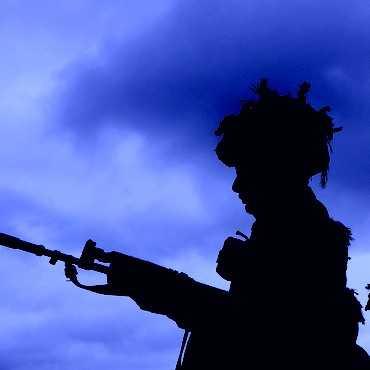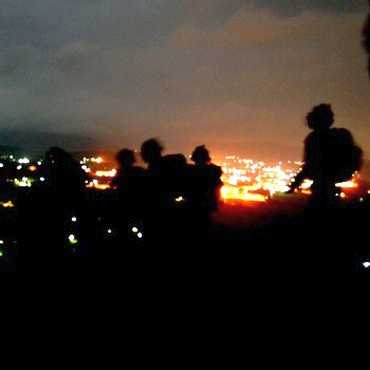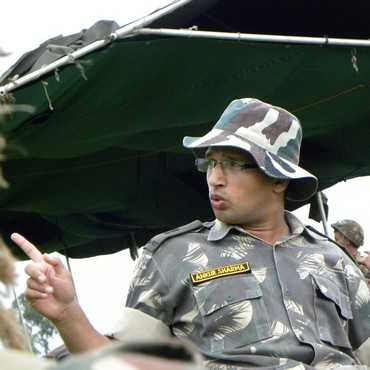Photographs: Hitesg Harisinghani Abhishek Mande
Rediff.com's Abhishek Mande and Hitesh Harisinghani are at the National Defence Academy's Camp Rover.
On the first day of a camp that tests the true mettle of NDA cadets, Abhishek accompanied the NDA's India squadron for a night-long trek.
When last heard, Abhishek spoke like a cadet on the move.
It is about 1.30 am on a Monday and I am walking on a footroad not more than 9 inches wide.
On any other Monday, I would probably be fast asleep under a warm blanket in the cosy comfort of my home in suburban Mumbai.
Today however I am with 23 cadets of the National Defence Academy's (NDA) India squadron trekking to reach a check post at Point 995 -- a peak about 900 m above sea level.
The weather gods have smiled upon us. There is thick fog -- the only thing visible is the silhouette of the person ahead of you -- but mercifuly it isn't raining very heavily. And since it is only a partially cloudy night, the path visible enough to walk on.
We are walking slowly in a single file. At one point, someone at the beginning of the file shouts out something that sounds like 'Be careful ahead'.
The cadet ahead of me is warned, looks around and tells me exactly what I don't want to hear -- "Whatever you do," he tells me, "Do not look on your left."
I do.
And I freeze.
PICS: Making of India's military leaders
Despite the fog, I know I am staring at a gorge that must be easily over 800 feet deep if not more.
At this point three thoughts go through my head:
"Crap. I'm scr**ed"
"What the hell was I thinking when I volunteered for this?" and
"Someone should have stopped me from doing this, like physically."
Then I take a deep breath and keep walking. There was no turning back now.
We move some 20 metres when the same voice shouts out: "Turn back. Now!"
As it turns out we were on the wrong path.
So we begin tracing our steps back.
Cadet K K Patil who is ahead of me now is rattling out instructions every seven steps. He gives me what will perhaps be the most useful advice of the evening. "If you're holding on to the grass, grab closest to the roots."
PICS: Making of India's military leaders
About seven minutes later, the advice comes handy. My foot slips but I find myself holding on to the absolute bottom of the 12-inch long wild grass growing along the slopes.
As we walk along, I say something in Marathi -- Patil's and my mother tongue -- the connotations of which only a native Marathi-speaking person can understad: 'Patil, sambhalun ghe re baba' ("Patil, take care of me, brother").
Patil laughs out loud assuring me that he'd be there for me. When we rest for a few minutes I realise he has a lot of questions to ask:
"Where are you from?"
"What newspaper do you write for?"
And perhaps the most poignant of them all:
"What are you doing here?"
I assure him he will have his answers the next day.
The 23 cadets of the India Squardon of the NDA and I are being led by Ankur Sharma, a bright young major of the Indian Army. He is about 28. The cadets are about 19. That makes me, 29, the oldest in the group.
Sharma is also an NDA alumnus and not very long ago, he too, like the cadets with us, had gone through the same drill before graduating in December 2004.
PICS: Making of India's military leaders
Tonight's exercise is part of Camp Rover, the Academy's bi-annual camp for the fourth term cadets. (The relatively easier Camp Greenhorn is for second term cadets while Camp Torna for the final term students is said to be more of an instructional camp).
Rover, or Rovers, as it is sometimes called, is said to be the toughest camp in its age category. For five long days, the cadets are put through intense exercises where their skill and spirit are put to test.
Day after each passing day, the exercises get tougher and the sleep deprived cadets -- they are given hardly any time to sleep in these five days -- reach the ultimate threshold of their endurance.
Today is the first day of the camp. Earlier, the 330 or so cadets have trekked some 6-odd kms to reach an interim camp where they take a break before they begin what is called the 'Night Walk' a 9-hour trek to the main campsite guided by nothing other than a compass and a map.
The Night Walk, I am told, is the easiest of the exercises that will follow. It is also the first all-night exercise where the cadets do not have the assistance of a GPS. So the chances of losing their way, as it happened with us, is very, very high.
Although there are officers with the squardons, who know the way and have a GPS with them, they do not help the map readers. The cadets have to make their way on their own.
PICS: Making of India's military leaders
Major Ankur Sharma comes from Himachal Pradesh. He is a first-generation armyman who was posted at Kupwara before arriving at the NDA a few years ago as an instructor. Sharma comes across as being an easy going person. He does not raise his voice but when he has to make his point, he does so with the ease of a diplomat. You might be sitting right next to him and think he's talking casually with a cadet till you see the young fellow suddenly go down on his hands and start doing push ups because he's done something wrong.
All the same, Major Sharma has a way of inspiring his boys. His experience in the Valley has taught him that the greatest success does not come without a motivated team.
Sharma often acts as the squardon's guide and voice of reason.
"Don't lose your heads," he keeps reminding them every once in a while.
A little after our great misadventure along the footroad, we reach a point where a particular corner baffles everyone. The rains and the 200-odd cadets who have crossed the very same path have made the ground slippery.
Everyone is trying to climb this one particular steep spot without much success. Two cadets have tried to go forth but have slipped almost seven feet down.
Sharma who is somewhere in the middle of the file takes the lead, climbs the steep slippery slope with seemingly no effort. Then he shouts out his words of wisdom: "Make your own path." And just like that he walks on.
PICS: Making of India's military leaders
The cadets figure their mistake. They avoid parts that their predecessors have taken and are now muddy and rather look for grassy portions to find foothold.
For some of us who are still struggling, he shouts out again, "Get on all fours."
By now we have crossed slushy fields, a couple of streams and mountains and a sleepy village with barking dogs. Tired, wet because of the off-and-on drizzle and exremely sleepy, we follow Sharma's instructions.
About 15 minutes later, we are walking on a relatively flat patch of road. The third check post of the night walk atop Point 995 doesn't seem to be very far away except that none of us can really see it.
"I think we are lost again!" Sharma says aloud and pulls up the map readers asking them to plot our location on the map. The two young boys flounder with the large piece of paper and mumble something.
Sharma hears them out patiently and continues walking.
"Are we really lost or are you calling their bluff?"
He smiles beatifically. "We're on track. I was testing them."
PICS: Making of India's military leaders
As we walk along Sharma tells me that this time of the night is crucial because everyone is really sleepy. If they're not kept on their feet they are bound to lose it. By the time it's 3 am, he says, they would have lost their sleep and be fresh.
Sometime later we finally reach the check post. Everyone drops to the ground. The squardon leader reports in to the two men at the check post.
Major Sharma saunters in and asks for the two map readers who'd misled the entire squardon. They are duly punished. While the rest of us are catching on our sleep, the two cadets are doing push-ups and sweating it out.
At about 5 am we reach a point where for the first time since we've left, we spot a tar road and a water bowser waiting for us. We still have two more check points to cross before we reach the main campsite.
The drizzling has not stopped but we have managed to cross the most difficult part of the trek.
Major Sharma who was with the map readers, breathing down their neck, is standing triumphantly on the street.
When I tell him I had never appreciated a tar road more in my life he laughs.
PICS: Making of India's military leaders
Then he turns to the cadets and takes their case. He tells them that they were running spectacularly behind schedule (which was true) and that he was allowing them to skip the fourth check post (this wasn't entirely true. The camp's commanding officer, Commander Peyush Pawsey had informed him that the road was getting too slippery to use. The cadets obviously had no business knowing this detail at the time).
We've been trekking for over eight hours. Despite the half dozen falls and some anxious moments, it has been a night to remember.
I have never trekked the entire night nor have I walked in such low visibility. I've never seen an entire stretch of a mountain below me covered in fog, nor have I seen the stars rise and set.
We walk along the tar road for a bit but I realise that my legs were now used to walking on slippery, uneven ground.
After some time, Major Sharma suggests we take a vehicle back to the campsite, a 10-minute drive. I am tempted to turn down the offer. I want to walk back with the rest of the squardon. But it has been a long night. So I give in.
I hoist myself on the extra high step of the army water bowser and crash on the seat. Sharma follows me and orders the driver, "Campsite chalo."
The engine revs into life. We're heading home.









Comment
article